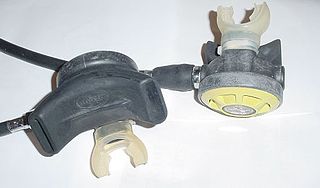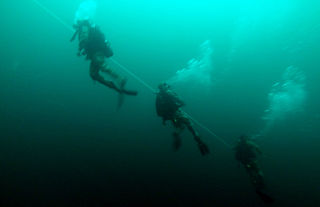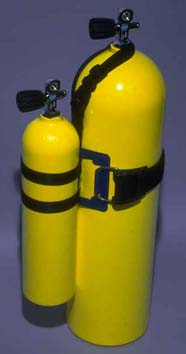
A scuba set, originally just scuba, is any breathing apparatus that is entirely carried by an underwater diver and provides the diver with breathing gas at the ambient pressure. Scuba is an anacronym for self-contained underwater breathing apparatus. Although strictly speaking the scuba set is only the diving equipment that is required for providing breathing gas to the diver, general usage includes the harness or rigging by which it is carried and those accessories which are integral parts of the harness and breathing apparatus assembly, such as a jacket or wing style buoyancy compensator and instruments mounted in a combined housing with the pressure gauge. In the looser sense, scuba set has been used to refer to all the diving equipment used by the scuba diver, though this would more commonly and accurately be termed scuba equipment or scuba gear. Scuba is overwhelmingly the most common underwater breathing system used by recreational divers and is also used in professional diving when it provides advantages, usually of mobility and range, over surface-supplied diving systems and is allowed by the relevant legislation and code of practice.

A diving cylinder or diving gas cylinder is a gas cylinder used to store and transport high pressure gas used in diving operations. This may be breathing gas used with a scuba set, in which case the cylinder may also be referred to as a scuba cylinder, scuba tank or diving tank. When used for an emergency gas supply for surface supplied diving or scuba, it may be referred to as a bailout cylinder or bailout bottle. It may also be used for surface-supplied diving or as decompression gas. A diving cylinder may also be used to supply inflation gas for a dry suit or buoyancy compensator. Cylinders provide gas to the diver through the demand valve of a diving regulator or the breathing loop of a diving rebreather.

A buoyancy compensator (BC), also called a buoyancy control device (BCD), stabilizer, stabilisor, stab jacket, wing or adjustable buoyancy life jacket (ABLJ), depending on design, is a type of diving equipment which is worn by divers to establish neutral buoyancy underwater and positive buoyancy at the surface, when needed.

Surface-supplied diving is a mode of underwater diving using equipment supplied with breathing gas through a diver's umbilical from the surface, either from the shore or from a diving support vessel, sometimes indirectly via a diving bell. This is different from scuba diving, where the diver's breathing equipment is completely self-contained and there is no essential link to the surface. The primary advantages of conventional surface supplied diving are lower risk of drowning and considerably larger breathing gas supply than scuba, allowing longer working periods and safer decompression. Disadvantages are the absolute limitation on diver mobility imposed by the length of the umbilical, encumbrance by the umbilical, and high logistical and equipment costs compared with scuba. The disadvantages restrict use of this mode of diving to applications where the diver operates within a small area, which is common in commercial diving work.

Scuba diving is a mode of underwater diving whereby divers use breathing equipment that is completely independent of a surface breathing gas supply, and therefore has a limited but variable endurance. The name scuba is an anacronym for "Self-Contained Underwater Breathing Apparatus" and was coined by Christian J. Lambertsen in a patent submitted in 1952. Scuba divers carry their own source of breathing gas, usually compressed air, affording them greater independence and movement than surface-supplied divers, and more time underwater than free divers. Although the use of compressed air is common, a gas blend with a higher oxygen content, known as enriched air or nitrox, has become popular due to the reduced nitrogen intake during long or repetitive dives. Also, breathing gas diluted with helium may be used to reduce the effects of nitrogen narcosis during deeper dives.

Diver rescue, usually following an accident, is the process of avoiding or limiting further exposure to diving hazards and bringing a diver to a place of safety. A safe place generally means a place where the diver cannot drown, such as a boat or dry land, where first aid can be administered and from which professional medical treatment can be sought. In the context of surface supplied diving, the place of safety for a diver with a decompression obligation is often the diving bell.
Buddy breathing is a rescue technique used in scuba diving "out-of-gas" emergencies, when two divers share one demand valve, alternately breathing from it. Techniques have been developed for buddy breathing from both twin-hose and single hose regulators, but to a large extent it has been superseded by safer and more reliable techniques using additional equipment, such as the use of a bailout cylinder or breathing through a secondary demand valve on the rescuer's regulator.

In underwater diving, an alternative air source, or more generally alternative breathing gas source, is a secondary supply of air or other breathing gas for use by the diver in an emergency. Examples include an auxiliary demand valve, a pony bottle and bailout bottle.

A bailout bottle (BoB) or, more formally, bailout cylinder is a scuba cylinder carried by an underwater diver for use as an emergency supply of breathing gas in the event of a primary gas supply failure. A bailout cylinder may be carried by a scuba diver in addition to the primary scuba set, or by a surface supplied diver using either free-flow or demand systems. The bailout gas is not intended for use during the dive except in an emergency, and would be considered a fully redundant breathing gas supply if used correctly. The term may refer to just the cylinder, or the bailout set or emergency gas supply (EGS), which is the cylinder with the gas delivery system attached. The bailout set or bailout system is the combination of the emergency gas cylinder with the gas delivery system to the diver, which includes a diving regulator with either a demand valve, a bailout block, or a bailout valve (BOV).

Underwater breathing apparatus is equipment which allows the user to breathe underwater. The three major categories of ambient pressure underwater breathing apparatus are:

Scuba gas planning is the aspect of dive planning and of gas management which deals with the calculation or estimation of the amounts and mixtures of gases to be used for a planned dive. It may assume that the dive profile, including decompression, is known, but the process may be iterative, involving changes to the dive profile as a consequence of the gas requirement calculation, or changes to the gas mixtures chosen. Use of calculated reserves based on planned dive profile and estimated gas consumption rates rather than an arbitrary pressure is sometimes referred to as rock bottom gas management. The purpose of gas planning is to ensure that for all reasonably foreseeable contingencies, the divers of a team have sufficient breathing gas to safely return to a place where more breathing gas is available. In almost all cases this will be the surface.

An emergency ascent is an ascent to the surface by a diver in an emergency. More specifically, it refers to any of several procedures for reaching the surface in the event of an out-of-gas emergency, generally while scuba diving.

Scuba gas management is the aspect of scuba diving which includes the gas planning, blending, filling, analysing, marking, storage, and transportation of gas cylinders for a dive, the monitoring and switching of breathing gases during a dive, efficient and correct use of the gas, and the provision of emergency gas to another member of the dive team. The primary aim is to ensure that everyone has enough to breathe of a gas suitable for the current depth at all times, and is aware of the gas mixture in use and its effect on decompression obligations, nitrogen narcosis, and oxygen toxicity risk. Some of these functions may be delegated to others, such as the filling of cylinders, or transportation to the dive site, but others are the direct responsibility of the diver using the gas.

Scuba skills are skills required to dive safely using self-contained underwater breathing apparatus, known as a scuba set. Most of these skills are relevant to both open-circuit scuba and rebreather scuba, and many also apply to surface-supplied diving. Some scuba skills, which are critical to divers' safety, may require more practice than standard recreational training provides to achieve reliable competence.

Surface-supplied diving equipment (SSDE) is the equipment required for surface-supplied diving. The essential aspect of surface-supplied diving is that breathing gas is supplied from the surface, either from a specialised diving compressor, high-pressure gas storage cylinders, or both. In commercial and military surface-supplied diving, a backup source of surface-supplied breathing gas should always be present in case the primary supply fails. The diver may also wear a bailout cylinder which can provide self-contained breathing gas in an emergency. Thus, the surface-supplied diver is less likely to have an "out-of-air" emergency than a scuba diver using a single gas supply, as there are normally two alternative breathing gas sources available. Surface-supplied diving equipment usually includes communication capability with the surface, which improves the safety and efficiency of the working diver.

The following outline is provided as an overview of and topical guide to underwater diving:

The following index is provided as an overview of and topical guide to underwater diving:
Diving procedures are standardised methods of doing things that are commonly useful while diving that are known to work effectively and acceptably safely. Due to the inherent risks of the environment and the necessity to operate the equipment correctly, both under normal conditions and during incidents where failure to respond appropriately and quickly can have fatal consequences, a set of standard procedures are used in preparation of the equipment, preparation to dive, during the dive if all goes according to plan, after the dive, and in the event of a reasonably foreseeable contingency. Standard procedures are not necessarily the only courses of action that produce a satisfactory outcome, but they are generally those procedures that experiment and experience show to work well and reliably in response to given circumstances. All formal diver training is based on the learning of standard skills and procedures, and in many cases the over-learning of the skills until the procedures can be performed without hesitation even when distracting circumstances exist. Where reasonably practicable, checklists may be used to ensure that preparatory and maintenance procedures are carried out in the correct sequence and that no steps are inadvertently omitted.

















